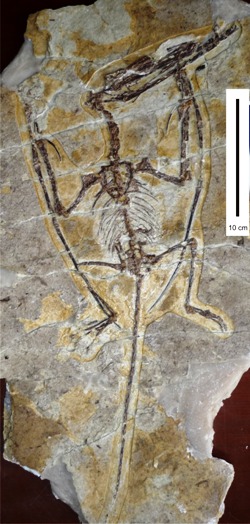
What we hadn’t realised was just how perceptive the toymakers were. Everybody knows that there were long-tailed pterosaurs (so-called ‘rhamphorhynchoids’) in the Triassic and Jurassic and short-tailed pterosaurs (pterodactyloids
#) in the Late Jurassic and Cretaceous. But clearly, short-tailed pterodactyloids must have evolved from long-tailed ‘rhamphorhynchoids’. In deed they did, and last year Lü Junchang of the Chinese Academy of Geological Sciences and David Unwin of Leicester University announced the discovery of a long-tailed pterodactyloid from the mid-late Jurassic Dhouagou Formation of China. This fabulous fossil was a ‘missing-link’ between these two pterosaur evolutionary grades and, being discovered in a Drwin bicentenary year was named
Darwinopterus.
But this amazing fossil had also been predicted by the toymakers and I take this opportunity of again publishing a picture of the toy that was the harbinger of fossils to come (and now arrived). Notice, if you will, that the toothy Pteranodon sports a splendid ‘rhamphorhynchoid’ tail, complete with terminal vane.
If you have a model of a prehistoric animal that you have bought for your kids (or for your very own collection!) and have noticed an irritating inaccuracy, please, don’t scoff, or ridicule the toy maker, the fossil is in the ground just waiting to be discovered.
#The term “rhamphorhynchoid” is used here in quotation marks because it is a vernacular for a paraphyletic clade, whereas “pterodactyloid” is a vernacular for the monophyletic, and therefore true, clade Pterodactyloidea. So in conversation, when talking about ‘rhamphorhynchoids’ (as you do), always raise your hands, isolate two fingers on each hand and, as you say ‘rhamphorhynchoid’, waggle them like twitching rabbit ears. DM
* Dave Martill works at the University of Portsmouth